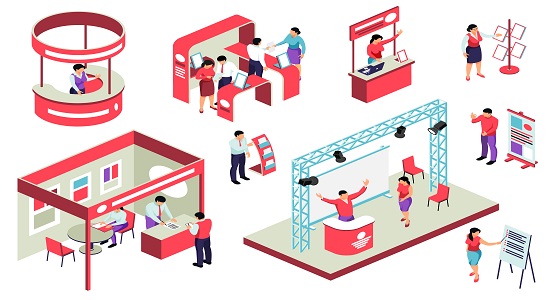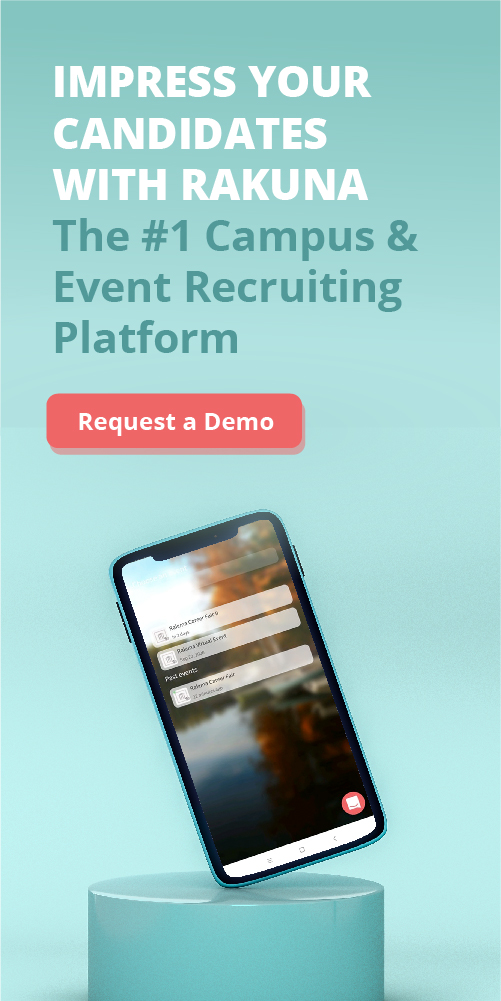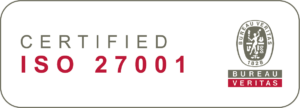Career fairs bring exciting opportunities for both job seekers and companies to learn about each other and interact. As an employer, these events give you chances to scout and attract the brightest students and fresh graduates. Thus, you should not only spend time preparing for career fairs but also evaluate your performance and identify areas for improvement in your event recruiting process.
To have the most accurate performance evaluation is to grasp the right statistics. Hence, event recruitment statistics are necessary tools to evaluate the success of events and optimize your performance. Understanding the following statistics can help you improve your campus recruitment strategy.
01. Pre-event Communication Effectiveness
Students actively seek job opportunities at campus recruitment fairs and on companies’ websites, making pre-event communication crucial. Rakuna’s Student Insights Report highlights that nearly 90% of students explore job prospects at career events, and two-thirds actively search for job postings on companies’ websites. Ensuring effective pre-event communication through the fair’s channels, company social media, and the official website is vital to enhancing awareness and attracting potential candidates to your booth.
Number of Sign-ups:
- Definition: The count of participants who have signed up for any pre-event activities or engagements.
- Purpose: Essential for assessing interest in specific activities, workshops, or sessions requiring pre-registration.
- Insight: High sign-up numbers indicate strong engagement with pre-event content, enabling targeted planning for activities with anticipated high attendance.
Leads Awareness:
- Definition: The number of leads who are aware of your company’s participation, measured through post-communication inquiries or surveys.
- Purpose: Provide insights into the effectiveness of your pre-event communication strategy in reaching and resonating with potential candidates.
- Insight: Understanding how leads learned about your participation helps refine communication channels and content, ensuring your message reaches the intended audience.
Source of Awareness:
- Definition: Categorizing leads based on where they learned about your participation (e.g., fair’s channels, social media, website, third-party collaborations).
- Purpose: Identify the most successful communication channels and sources of awareness among your target audience.
- Insight: Enables strategic optimization of communication efforts, allowing you to allocate resources effectively based on the most impactful channels.
Cost per Lead:
- Definition: The average cost incurred for each lead generated through pre-event communication efforts.
- Purpose: Evaluate the efficiency and cost-effectiveness of various communication channels and strategies.
- Insight: Pinpoints the channels with the lowest cost per lead, allowing for budget optimization and maximizing ROI on pre-event communication.
Engagement Rate:
- Definition: Measures the level of engagement with your pre-event content, such as social media interactions, clicks, or reactions.
- Purpose: Assess the resonance and impact of your communication efforts.
- Insight: High engagement rates indicate compelling content, while low rates may suggest the need for adjustments in messaging or delivery.
Survey Feedback:
- Definition: Gathering feedback through pre-event surveys to understand participants’ expectations and perceptions.
- Purpose: Provides qualitative insights into the effectiveness of your communication strategy and areas for improvement.
- Insight: Direct feedback allows for nuanced adjustments to communication approaches, ensuring they align with the audience’s preferences.

Designed by Freepik
02. Attendance Data
Attendance data is a cornerstone among essential event recruiting statistics for every campus recruitment manager. Effectively evaluating your success in attracting the target group requires a comprehensive analysis of these key attendance metrics.
Number of Booth Visitors / Total Event Visitors:
- Definition: This ratio illustrates the overall attractiveness of your company at the event, derived from the number of visitors to your booth compared to the total attendance.
- Purpose: Gauges the impact of your employer’s pre-event marketing efforts and assesses your team’s performance during the event.
- Insight: A higher ratio indicates successful pre-event marketing and compelling booth engagement, while a lower ratio may necessitate adjustments to enhance the overall appeal.
Enhancement Strategies:
- Booth Design: Create an inviting and visually appealing booth set up to attract attention.
- Engagement Activities: Plan interactive activities and sessions to increase booth foot traffic.
- Pre-event Hype: Generate excitement through teasers and exclusive event promotions.
Booth Visitors in Categories:
- Definition: Categorizing booth visitors based on their level of education, areas of interest, or the specific jobs they are planning to apply for.
- Purpose: Provides a nuanced understanding of the demographics and preferences of the attendees, enabling targeted adjustments.
- Insight: Identifies whether your booth is attracting the right audience, aiding in refining your targeting strategy for future events.
Enhancement Strategies:
Imagine you attract a substantial number of booth visitors, but analysis reveals that a majority are freshmen. However, your goal is to recruit fresh graduates for available positions. This disparity in attendance data signals a mismatch in targeting, prompting the campus recruitment manager to enact strategic adjustments for upcoming career fairs.
- Customized Signage: Clearly display information that resonates with different education levels and career interests.
- Interactive Surveys: Incorporate short surveys or interactive elements to gather insights from visitors.
- Job-specific Promotions: Tailor your marketing materials to highlight roles relevant to different categories.
- Year-specific Engagement: Create tailored engagement activities targeting specific academic years.
- Information Sessions: Conduct sessions that appeal specifically to fresh graduates, providing insights into career paths and opportunities.
Geographical Representation:
- Definition: Understanding the geographic locations of attendees, including their universities and regions.
- Purpose: Assists in assessing the regional reach and effectiveness of your recruitment efforts.
- Insight: Pinpoint areas where your company has strong appeal and areas for potential expansion.
Enhancement Strategies:
- Regional Marketing Campaigns: Leverage attendance data to focus marketing efforts in areas with a high concentration of interested candidates.
- University Partnerships: Strengthen relationships with universities in regions with low representation to increase visibility.
Engagement Duration:
- Definition: Measuring attendees’ average time spent at your booth or in conversations with recruiters.
- Purpose: Indicates the level of interest and engagement with your company.
- Insight: Helps evaluate the effectiveness of booth activities and recruiter interactions.
Enhancement Strategies:
- Interactive Activities: Introduce engaging activities to keep attendees at the booth for longer durations.
- Effective Conversations: Train recruiters to initiate meaningful conversations that capture attendees’ interest.
Return Visitors:
- Definition: Identify attendees who visit your booth on multiple occasions during the event.
- Purpose: Highlights sustained interest and provides insights into the effectiveness of follow-up strategies.
- Insight: Differentiates between one-time interactions and ongoing engagement with your company.
Enhancement Strategies:
- Retention Strategies: Develop strategies to maintain engagement with return visitors, such as exclusive follow-up sessions.
- Memorable Experiences: Create a booth atmosphere that encourages return visits through memorable experiences.
03. Visitors’ Level of Engagement During Event
Ensuring high engagement levels at your company’s booth during a career fair is pivotal for successful campus event recruiting campaign. The level of interaction between visitors and your team provides valuable insights into the effectiveness of your strategies and the overall appeal of your employer brand. Here are key factors to consider when evaluating and enhancing visitors’ engagement during the event:
Booth Design and Layout:
- Definition: Assessing the visual appeal, functionality, and accessibility of your booth’s design and layout.
- Purpose: Determines the immediate impression your booth makes and how inviting it is to attendees.
- Insight: Identifies aspects of the booth that attract or deter visitors, influencing their decision to engage.
Enhancement Strategies:
- Interactive Zones: Designate areas within the booth for interactive activities or demonstrations.
- Branding Visibility: Ensure prominent and visually appealing branding elements that stand out in the crowded event space.
Employer Giveaways and Promotional Items:
- Definition: Evaluating the popularity and effectiveness of giveaways and promotional items offered to visitors.
- Purpose: Measures the tangible impact of freebies on attracting and retaining visitor interest.
- Insight: Helps determine the relevance and desirability of promotional materials among the target audience.
Enhancement Strategies:
- Targeted Giveaways: Align promotional items with the interests and preferences of the target demographic.
- Limited Edition Items: Create exclusivity and urgency by offering limited or event-specific giveaways.
Company Representatives’ Performance:
- Definition: Evaluating the effectiveness of your team in initiating conversations, answering queries, the number of interested leads generated, and showcasing the company culture.
- Purpose: Assesses the impact of interpersonal interactions on visitor perception and interest.
- Insight: Identify strengths and areas for improvement in your team’s engagement skills.
Enhancement Strategies:
- Training Programs: Provide ongoing training to representatives on effective communication and rapport-building.
- Employee Stories: Encourage representatives to share personal stories that resonate with the target audience.
Technological Integration
- Definition: Examining the use of technology, such as interactive displays, virtual reality, or digital presentations, to enhance engagement. You can also analyze and compare this element between your booth and other identified competitors in the event.
- Purpose: Measures the adoption and impact of technology in creating a dynamic and modern booth experience.
- Insight: Identifies the tech preferences of the target demographic and the effectiveness of digital interactions.
Enhancement Strategies:
- Immersive Experiences: Implement virtual or augmented reality experiences to captivate tech-savvy attendees.
- Digital Presentations: Showcase company highlights and opportunities through visually engaging digital presentations.
Feedback and Interaction Analytics:
- Definition: Collecting and analyzing real-time feedback, questions, and interactions with booth representatives.
- Purpose: Provides immediate insights into visitor sentiments, concerns, and preferences.
- Insight: Helps adapt strategies on-the-fly and addresses visitor needs during the event.
Enhancement Strategies:
- Feedback Stations: Set up stations for visitors to provide feedback or share their experiences.
- Live Polls: Use interactive polls or surveys to gauge attendees’ opinions and preferences.
04. Visitors’ Level of Engagement Post-event

Designed by Freepik
The conclusion of a career fair doesn’t mark the end of your engagement strategy—it’s a transition to the post-event phase, where sustained interactions and follow-up play a crucial role.
Measuring visitors’ responsiveness post-event provides valuable insights into the effectiveness of your outreach efforts and helps shape your ongoing recruitment strategy. Here’s a comprehensive look at the elements to consider when evaluating visitors’ engagement after the event:
Social Media Interaction
- Definition: Assessing the level of interaction, such as likes, shares, comments, or mentions, on social media platforms.
- Purpose: Measures the resonance of your post-event content and the ongoing interest of attendees.
- Insight: Identifies the popularity of specific posts, topics, or engagement campaigns among your target audience.
Enhancement Strategies:
- Interactive Content: Share engaging content like event highlights, behind-the-scenes glimpses, or interactive polls.
- Event Photo Albums: Create and share photo albums capturing memorable moments from the career fair.
Newsletter and Email Engagement
- Definition: Analyzing open rates, click-through rates, and responses to newsletters or post-event emails.
- Purpose: Gauges the effectiveness of email communication in retaining interest and providing valuable information.
- Insight: Identifies the content and messaging styles that resonate with the audience.
Enhancement Strategies:
- Personalized Content: Tailor newsletters with personalized content based on attendees’ preferences and interests.
- Highlight Opportunities: Showcase upcoming opportunities, company updates, or success stories to maintain engagement.
Job Opportunity Emails and Applications:
- Definition: Tracking the number of job opportunity emails opened, clicked, and subsequent applications submitted.
- Purpose: Measures the conversion of engagement into actionable steps in the recruitment process.
- Insight: Identifies the relevancy and appeal of job opportunities presented to post-event visitors.
Enhancement Strategies:
- Segmented Job Alerts: Provide personalized job alerts based on attendees’ expressed preferences during the event.
- Application Assistance: Offer support or additional information for those navigating the application process.
Follow-up Interviews and Conversations:
- Definition: Monitoring the number of follow-up interviews scheduled or initiated post-event.
- Purpose: Assesses the conversion of initial event interest into deeper engagement and potential recruitment.
- Insight: Identifies the effectiveness of post-event communication in nurturing leads and fostering ongoing dialogue.
Enhancement Strategies:
- Prompt Follow-ups: Initiate follow-up communications promptly after the event to capitalize on recent interactions.
- Tailored Conversations: Personalize follow-up messages based on specific discussions or interests expressed during the event.
Survey and Feedback Responses:
- Definition: Collecting responses from post-event surveys or feedback requests.
- Purpose: Gather insights into attendees’ overall experience, satisfaction levels, and areas for improvement.
- Insight: Provides actionable feedback to enhance future events and communication strategies.
Enhancement Strategies:
- Incentivized Surveys: Encourage participation through incentives like exclusive content, discounts, or giveaways.
- Continuous Improvement: Act on constructive feedback to continually refine and improve your post-event engagement approach.
Conversion Metrics:
- Definition: Tracking the conversion of post-event engagement into tangible outcomes, such as applications, interviews, or hires.
- Purpose: Measures the ultimate impact of your post-event efforts on recruitment and talent acquisition.
- Insight: Quantifies the success of your engagement strategies in driving desired outcomes.
Enhancement Strategies:
- Performance Benchmarks: Establish benchmarks for conversion metrics to assess success relative to goals.
- Iterative Optimization: Continually optimize post-event engagement strategies based on conversion data and evolving recruitment objectives.
05. Overall Event Recruiting Performance
While tracking specific career fair statistics at each stage is crucial, a comprehensive assessment of overall performance indicators provides a bird-eye view of the effectiveness and impact of your campus recruitment efforts. Here are key indicators that should be integral to your evaluation process:

Designed by Freepik
Total Engagement Metrics:
- Definition: Sum of individuals engaging with your recruitment activities, including sign-ups, information submissions, CV submissions, and job applications.
- Purpose: Measures the overall reach and appeal of your campus recruitment initiatives.
- Insight: Identifies the collective impact of your activities in building a robust talent pool for current and future hiring needs.
Enhancement Strategies:
- Promotional Activities: Leverage targeted promotional activities to enhance overall engagement levels.
- User-Friendly Platforms: Ensure seamless and user-friendly platforms for easy interaction and participation.
Number of Qualified Candidates:
- Definition: Count of individuals identified as qualified candidates based on specified criteria.
- Purpose: Gauges the success of your recruitment strategy in attracting candidates who align with your hiring requirements.
- Insight: Provides a qualitative measure of the talent pool generated through campus recruitment activities.
Enhancement Strategies:
- Refine Target Criteria: Continuously refine and update criteria for identifying qualified candidates based on evolving hiring needs.
- Tailored Messaging: Tailor messaging to attract candidates with the desired skills and qualifications.
Cost per Candidate or Sign-Up:
- Definition: Calculated cost incurred for recruitment activities, marketing campaigns, materials, and related costs per candidate or individual sign-up.
- Purpose: Evaluate the efficiency of your recruitment budget and the return on investment (ROI) per engaged candidate.
- Insight: Assesses the cost-effectiveness of different recruitment channels and strategies.
Enhancement Strategies:
- Budget Allocation Optimization: Allocate resources to the most effective channels based on cost per candidate data.
- Refinement of Marketing Strategies: Continuously optimize marketing campaigns to enhance cost-effectiveness.
Conversion Rates at Each Stage:
- Definition: Percentage of individuals progressing through each stage of the recruitment process (e.g., from sign-up to CV submission, from CV submission to application).
- Purpose: Identifies bottlenecks or areas of improvement in the recruitment funnel.
- Insight: Pinpoints the effectiveness of your communication and engagement strategies at different stages.
Enhancement Strategies:
- Streamlined Processes: Implement streamlined and user-friendly processes to improve conversion rates.
- Personalized Communication: Personalize communication to address specific concerns or challenges faced by candidates at different stages.
Retention and Engagement Beyond Recruitment:
- Definition: Measurement of candidates’ continued engagement and retention within your talent pool beyond the recruitment event.
- Purpose: Assess the effectiveness of your engagement strategies in building lasting connections.
- Insight: Identifies opportunities for ongoing communication and relationship-building.
Enhancement Strategies:
- Post-Event Engagement Plans: Develop post-event engagement plans to nurture relationships with candidates.
- Exclusive Opportunities: Offer exclusive opportunities or content to maintain interest and engagement.
Brand Perception and Feedback:
- Definition: Gathering feedback and assessing the overall perception of your company’s brand among engaged individuals.
- Purpose: Provides insights into how your company is perceived and the impact of your recruitment efforts on brand reputation.
- Insight: Identifies strengths to leverage and areas for improvement in brand positioning.
Enhancement Strategies:
- Feedback Mechanisms: Establish channels for collecting feedback and insights from engaged individuals.
- Brand Image Enhancement: Continuously work on enhancing your employer brand through strategic initiatives.
Recommendations
Employers may use various indicators based on recruitment goals, but campus recruitment teams should anticipate receiving substantial student data. According to Rakuna’s Student Insights Report, employers typically respond within one-week post career fair.
Recruiting teams should leverage HR technology tools to efficiently manage this influx of information and ensure prompt responses to potential candidates. These tools streamline manual tasks, organize candidate data, and assess recruiting source quality
Tools like Rakuna’s Campus & Event Recruiting Solution streamline manual tasks, organize candidate data, and facilitate seamless team cooperation on a single virtual platform.
Whether it is in-person or virtual recruiting events, we always have your back covered. Streamline your event recruiting operation with powerful features like Kiosk Mode, Instant Candidate Resumes Capture, and a detailed Candidate Database.
Want to see Rakuna in action? Book a free demo today.
Conclusion
In conclusion, knowing and understanding which career fair statistics to measure and monitor are needed to optimize your campus recruiting strategy. Recruiting teams should constantly track and monitor stats to keep your recruitment endeavors stay on track. You can use recruitment tools to optimize your performance, build an effective strategy, and stay ahead of your competitors.


